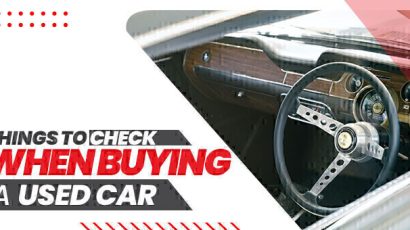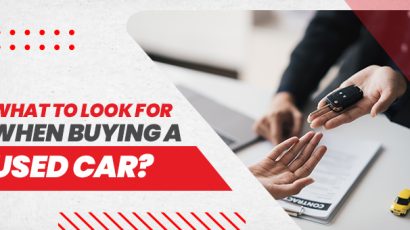
In today’s economic environment, buying a used car is a financially sound decision. However, unlike purchasing a new car with a warranty, buying used requires more due diligence. To ensure you’re not inheriting a money pit disguised as a shiny set of wheels, a thorough inspection is crucial. This article equips you with the essential steps to buy a car, including inspection tips, and empowers you to make a confident and informed decision.
1. Gather Your Resources
Before you embark on your used car inspection journey, gather the necessary tools and information. Firstly, find out everything about the model of your interest. Read reviews about common problems and maintenance costs. With this information, you can better spot potential problems during the inspection.
Next, create a checklist to make sure you don’t miss anything important. There are many downloadable checklists available online, or you can create your own. Finally, consider bringing a mechanic friend or a trusted professional along for the inspection. Their knowledge and expertise are invaluable in detecting concealed issues.
2. Check the Vehicle History Report
A vehicle history report is an important resource. It provides a comprehensive understanding of the history of a used vehicle. Obtain a report from a reputable source, such as Carfax or AutoCheck. This report will reveal accidents, major repairs, odometer rollbacks, and outstanding titles or liens. A clear history report indicates a good car, but it doesn’t guarantee a perfect car. However, a history report riddled with problems raises concerns, and you should look for another option immediately.
3. Inspect the Exterior Diligently
First impressions matter, and a car’s exterior condition can speak volumes about its overall care. Begin by inspecting the car from all sides and try to spot scratches, dents, or rust spots. These imperfections could indicate past accidents, poor repairs, or neglected maintenance.
Next, inspect the lights, windows, and mirrors for cracks, chips, or misalignment. Then, move on to the tires and inspect their condition. Often, uneven wear can indicate suspension problems or improper alignment. Don’t forget to open the trunk and hood. Look for signs of rust, leaks, or water damage.
4. Peek under the Hood: Assessing the Engine Bay
While you might not be a mechanic, there’s still valuable information to glean from a peek under the hood. Look for warning signs like excessive corrosion or leaks. The engine bay should be clean and free of dirt. Lastly, check the oil dipstick for the oil level and color. A promising sign of good condition is a light brown oil color. Furthermore, the level should be within the recommended range.
Moreover, if you’re uncomfortable assessing the engine bay yourself, having your mechanic friend or a professional mechanic take a look is a wise decision.
5. Move Inside: Inspecting the Interior
Now, begin inspecting the inside of the vehicle. Open all the doors and inspect the seats, carpets, and upholstery for rips, tears, or stains. Ensure all the seats can be adjusted easily and the seatbelts function smoothly.
After that, check the ignition by turning it on and taking a look at the dashboard. All warning lights should illuminate briefly during start-up and then turn off. Check all electrical features, including the air conditioning unit, windows, and power locks.
Finally, take a moment to assess the overall creature comforts of the car. For instance, try to assess whether the seats are comfortable and spacious enough. Is the driving position comfortable?
6. Fire it Up: The Test Drive
The test drive is nevertheless an important step in the course of inspection. Giving it a test drive allows you to get a better feel for the car and see any possible issues with its operation.
As you switch the engine on, try to listen for any unusual noises. Moreover, while driving, pay attention to the handling, acceleration, and braking. Check if the car pulls to one side. Is the acceleration smooth? Does the braking feel spongy or uneven?
Try to drive the vehicle on various surfaces like busy city streets as well as the highway. It should help in assessing its performance on various terrains.
7. Don’t Forget to Negotiate
Now that the test drive and inspection are over, it’s time to talk about the price of it. With all the information that you have from the inspection, you’re in a strong position to negotiate a fair price. Use the identified issues, such as cosmetic damage, a sketchy service history, or questionable performance during the test drive, as leverage to lower the asking price.
However, remember to be polite and professional throughout the negotiation process. Explain your concerns clearly and walk away if you can’t reach an agreement on price with the seller.
8. Get a Pre-Purchase Inspection (Optional but Highly Recommended)
While the steps outlined above will equip you to conduct a thorough inspection, consider getting a pre-purchase inspection by a qualified mechanic as an added layer of security. This inspection involves a comprehensive examination of the major parts, such as the engine, transmission, brakes, and suspension.
The mechanic will give you the details in writing, outlining any problems they find and estimated repair costs. This information is invaluable in determining if the car is worth buying and how much you should budget for potential repairs.
9. Trust Your Gut
Throughout the inspection process, don’t ignore your gut feeling. If you feel something about the car or the seller isn’t right, pay attention to it. There are plenty of used cars on the market, so walk away if you’re not comfortable or convinced.
Bottom Line
In conclusion, purchasing a used vehicle can be rewarding, but it requires thorough research and attention to detail. Therefore, by following the essential steps to buy a used car, you’ll be well-equipped to inspect a used car thoroughly and make an informed decision. Remember, a little time and effort invested upfront can save you a lot of money and frustration down the road. Happy car shopping!










